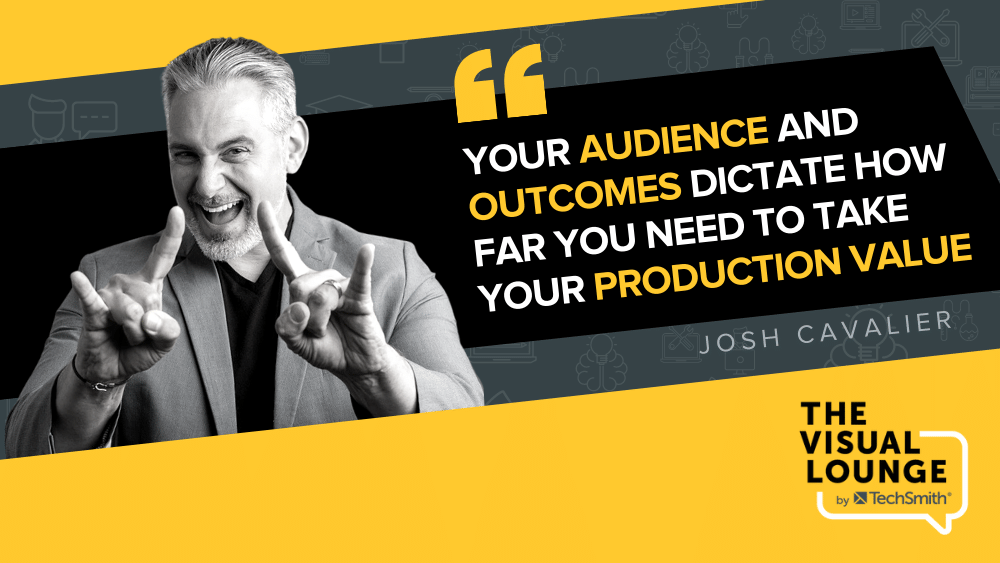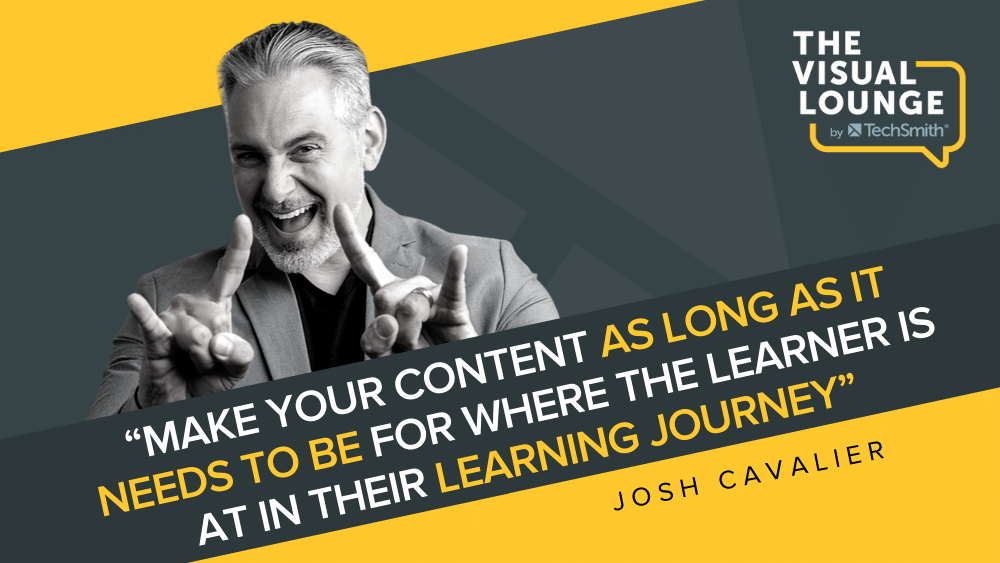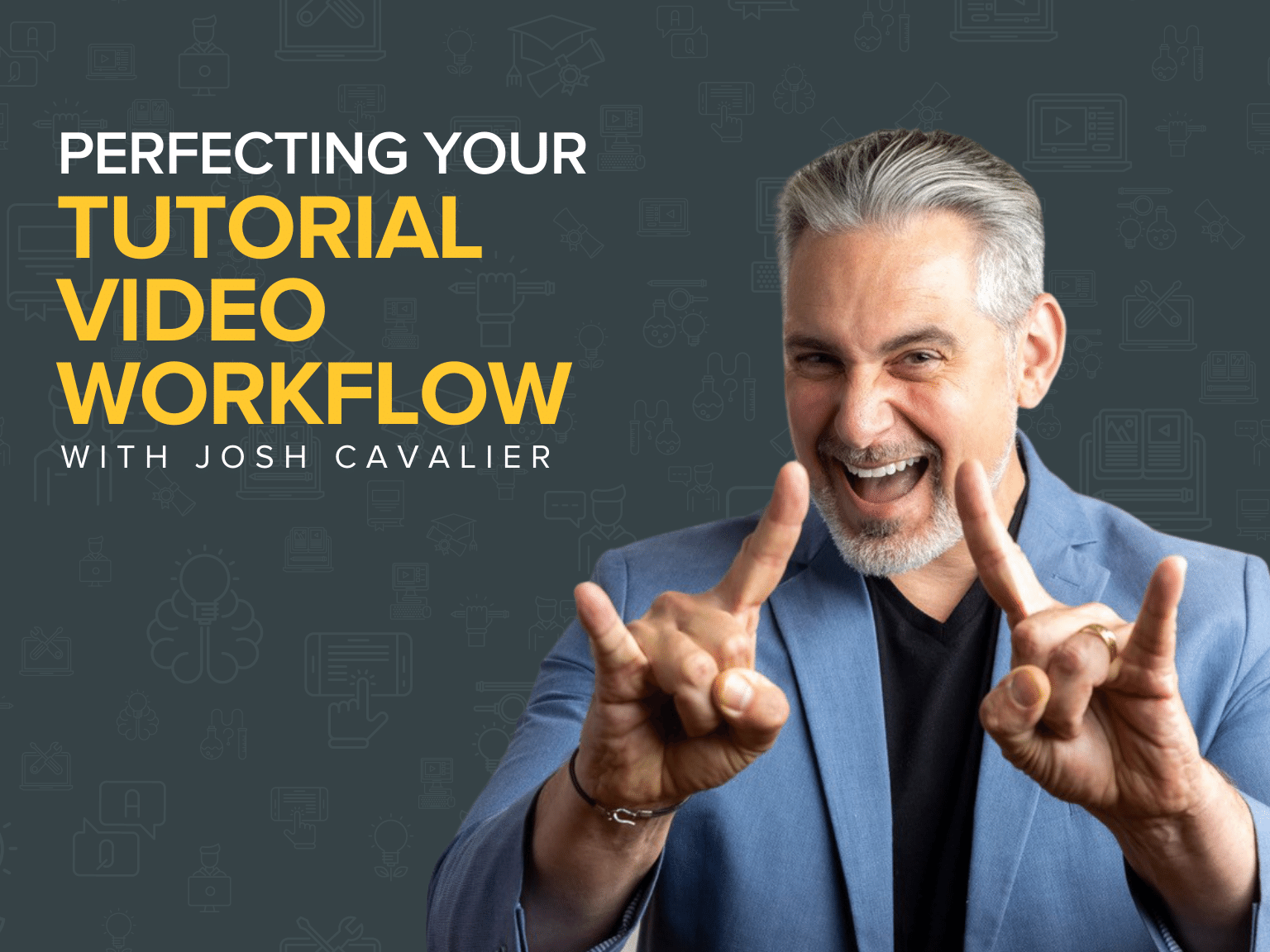Tutorial videos are a fantastic way to connect with your audience through teaching and learning. But is there such a thing as a one-size-fits-all tutorial video workflow?
Josh Cavalier has over 25 years of experience in learning and development and is a passionate instructional video creator. He joins The Visual Lounge to share how he adapts his tutorial video workflow to ensure highly effective instructional videos.
This episode is packed with actionable advice that will revolutionize how you approach your tutorial video workflow.
You can watch the video on this topic above, to listen to the podcast episode below, or read on for more…
What does it mean to have a tutorial video workflow?
A workflow is the steps you take to get the outcome you want. For Josh, designing a workflow means focusing on his audience and knowing what results they need to achieve. He can then work backward from here and create a workflow that’s going to help his audience reach the desired end-result.
Josh says that, from an instructional standpoint, the goal is usually to change behaviors, attitudes, or teach some new information. Once you know which goal your content is aiming for, you can begin to modify your workflow and then move forward with your video production.
Understanding barriers to entry
One of the biggest challenges to how successful an instructional video is, is how easy it is to access. Josh notes that removing any barriers to entry for your video is the best way for it to reach and help as many people as possible.
When planning your tutorial video workflow, you need to think about where the video is ultimately going to live. Will an elearning course be inserted? Hosted within a content management system? These could be seen as barriers when people have instant access to other types of learning content (such as YouTube and TikTok).
Josh says that asking these “ease-of-access” questions is a vital part of his workflow process.
“I’m not only thinking about the creation process, but the access. Where is it going to be stored? How is it going to be consumed? Am I going to get any analytics from the back end that I can then use to try and confirm from a measurement standpoint if some of our objectives have been met?”
Crafting video tutorials as part of a learning journey
Tutorial videos are often used as part of a much wider “learning journey”. But what does this mean for you and your viewers?
The first stage is awareness. Josh says that your audience needs to know what’s in it for them and why they should care before they’re going to commit to watching that video.
We’re bombarded with so much content every day, that everyone’s constantly making judgement calls about what is and isn’t worth their time. Josh recommends thinking about how you’re going to market your instructional content to convince people that it’s worth consuming.
Josh says that this initial part of the learning journey needs to tap into people’s emotions. What he means by this isn’t necessarily about making people happy or sad, but creating content that motivates the learner to listen.
To do this, Josh uses a variety of techniques such as showcasing company leaders (to create intrigue and add weight to the content) and discussing learning objectives so the learner is fully aware of what they have to gain.
After this initial stage, Josh moves through a learning journey that looks something like this:
- Awareness stage (why the learner should care about this content)
- Pre-training (priming people for what they’re about to learn)
- Training (the knowledge-transfer stage)
- Post-training (reinforcing what they’ve learned)
- Performance support (helping the learner apply their new knowledge)
How the learning journey affects your video tutorial workflow
Josh notes that a video tutorial isn’t the solution for every stage. To find out what content best suits your audience at each stage, you need to understand what content your audience prefers consuming and where they’re consuming it. Thinking about audience preferences and what you learned when asking those ease-of-access questions is going to help you greatly when making these decisions.
If you’ve chosen to create a video, Josh encourages you to think about how the whole journey will work.
“By thinking about the whole entire learning journey, you will find opportunities from a recording and creation standpoint, that you’ll have never seen before.”
As an example, Josh says that if you’re planning to record a leader speaking, you may have limited time and contact with that person. When you can think about the entire learning journey and how each piece works together, you may realize that you can get multiple pieces of content recorded in one go. You can then feed these content pieces into different stages across the learning journey. However, if you’re just thinking about one stage at a time, you may miss the opportunity to bring that speaker back later to reinforce messages or raise emotion.
How to spark emotion with your video tutorials
If you’re unsure about how to make your learning videos more “emotional” – or why you’d want to – Josh suggests thinking about emotion as a way to grab the learner’s attention.
“What we’re trying to do is get the user in a state of being that’s active listening and active watching.”
He explains that when we sit and watch a 90-minute movie, we’re captivated. But for a 6-minute training video, we might struggle to pay attention. By thinking about where you can place “emotional fenceposts” you can encourage your learner to stay connected to the content.
One way to bring that emotional aspect into your tutorial videos is to include people.
Josh says that breaking up your video by introducing new or returning speakers and getting them to move the topic along is fantastic for reducing your learner’s cognitive load as well as humanizing your content.
Another way to ensure your learners stay engaged is to introduce more variety into your content. If you do a series of videos with the same background, same shirt, same delivery, your audience will struggle to maintain their interest. But if you keep your content varied, people will naturally pay more attention.

Josh notes that while subtle changes to your background, clothing, and delivery are all recommended to keep your audience engaged, you should be “strategic” about incorporating bigger elements, such as music.
“I’ve seen training videos where it’s very over the top in regards to that forced emotion, like maybe they’re putting music in the background of a step by step instructional video for a system based training. Why is the music there?”
Josh’s advice is to think critically about where you place your emotional fenceposts. Think about whether they add to the learning experience, or just put strain on the learner’s cognitive load. Music at the beginning of a video, for example, is a great way to catch a learner’s attention. But consider if you really need it during the training stage.
How long should a tutorial video be?
While there’s no perfect length for an instructional video to be, Josh says that you can work out how much a learner needs to know depending on where they are in their instructional journey.
A good way of thinking about this is to think about where you need high level information versus detailed information. If you want to learn to fix your washer, you’re likely to watch an entire video to make sure you don’t miss any steps. But, if you just need one very specific piece of information, it’s less likely that you’ll stick around and watch the whole video.

Josh says that a big problem right now is people jumping on the micro-content bandwagon
While short-form content may be the solution in some cases, when it comes to instructional video, it’s not one-size-fits-all.
“A lot of individuals who hear terms like micro-learning will intentionally try to make something short. That’s not always the best strategy. The best strategy is making the content as long as it needs to be for where the learner is in their learning journey.”
But what if a learner just needs to know a small part of a longer process? You might have created a video with the answer they’re looking for. But because it’s hidden in a longer format, your learner may not be able to find the content they need. In this case, they may go looking for help elsewhere.
This comes back to Josh’s thoughts on ease-of-access. By thinking about learner’s goals, you can craft a better learning experience for them. To solve this problem, Josh suggests making long form content more accessible. Do this by tagging chapters and adding time codes so the audience can access the specific content they’re looking for, without having to scrub through a longer video. This results in greater success for your learner and your video.
Josh’s top tip for creating a perfect tutorial video workflow
A tutorial video workflow may look different every time depending on your budget, time, and what you’re able to produce. Josh says, no matter what limitations he’s working with, he always aims high.
“In my mind, I’m always thinking, infinite time, infinite money, what would be the best solution for this from a video or instructional standpoint, elearning, whatever the case may be, what is the optimal solution? If I had all the time and all the money, that there’s the solution. Now I’m gonna go ahead and work that back to my reality.”
Josh’s advice: think big! Then work out how you can (realistically) execute it. There’s no better place for learning how to create instructional and tutorial videos than the TechSmith Academy! Check it out for tips and advice, and dos and don’ts from some of the world’s leading tutorial video creators.
For more expert advice and tips visit TechSmith Academy on YouTube or listen to the Podcast.





